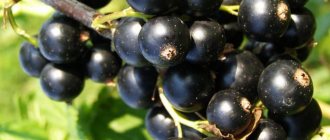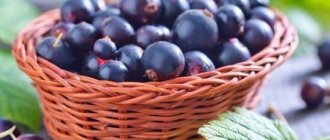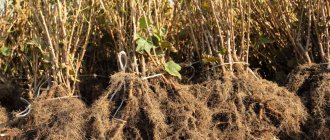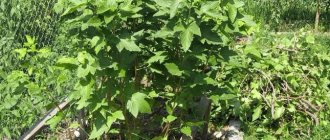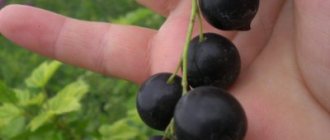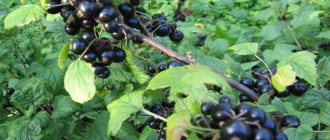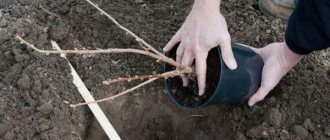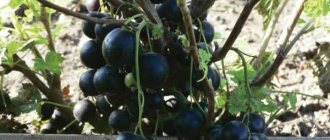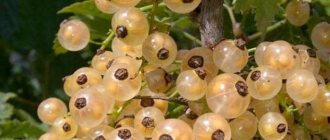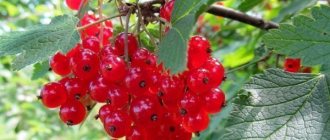History of selection
Blackcurrant fruits are characterized by a high content of vitamin C; an adult needs only 20 berries to meet their daily requirement. The berry is rich in vitamin P, it contains potassium, pectin, carotene, B vitamins, and amino acids.
Leningrad sweet currant, or Veloy (Viloy) was obtained through selection in the last century at the Pavlovsk experimental station of the All-Russian Research Institute of Plant Growing. The following varieties were taken as material: Leningrad Giant and Ojebin. Entered into the State Register in 1993.
Reviews from gardeners
The popularity of black currant “Velaya” in our country and abroad is due to the high winter hardiness and productivity of the plant. Reviews from gardeners characterize the variety as large-fruited and early-fruiting. Proper care of berry bushes guarantees the production of berries with excellent taste. Currants are in demand not only fresh, but also for making desserts or winter preparations.
The variety has performed well when cultivated in most regions of Russia and is highly resistant to damage by major fungal diseases. However, it must be remembered that as a result of overripening of currants, the skin on large berries may crack, so harvesting should be done in a timely manner. Compliance with the rules of agricultural technology when growing berry crops can significantly reduce the need to use strong and toxic chemicals for the prevention and treatment of plants.
Main advantages and disadvantages
This variety of currants has many positive qualities, but there are several disadvantages.
The advantages include:
- Young shoots give a good harvest the next season.
- The fruits are large and sweet.
- From one bush you can get 4-5 kg of berries.
- The plant is self-pollinating; bees are not required for pollination.
- The fruits retain their integrity during transportation.
- The variety is not afraid of cold weather and is resistant to many diseases and pests (powdery mildew, mites).
One of the disadvantages is that currant berries ripen at different times; overripe ones burst during picking.
Varietal characteristics
Chokeberry called “Veloy”, in addition to high yield and excellent winter hardiness, has a number of advantages that allow this variety to be rated very highly. The description and characteristics of the variety are of interest to both experienced and novice gardeners.
| Bushes | Medium-sized, semi-spreading, medium density |
| Young shoots | Thickened, weakly and unevenly colored, pale pink, with pubescence |
| Adult shoots | Thickened, erect, grayish-brown or beige in color with a brown apical part. Pubescence present |
| Kidneys | Medium type, thick, short, ovoid, with a pointed apical part. They are colored pinkish or pinkish-lilac. Characteristically dense pubescence. They are located parallel to the shoot. The base is pressed, the top is deflected |
| Leaves | Five-lobed, large in size, dark green with a bronze tint. The surface is matte, with characteristic pubescence along the veins |
| Petioles | Thickened, medium length, with relative pubescence. Insufficiently uniform coloring at the base |
| Flowers | Large in size, goblet-shaped, low-set, greenish-white in color with a slight pinkish tint and strong pubescence |
| Brushes | Short or medium, contain at least 5 to 8 berries |
| Berries | Large or very large, weighing more than 3.5-3.7 g, round or flat-round in shape. The color of the thin skin is black, with a slight shine. The berries are semi-dry and have a significant amount of seeds in the pulp. |
| Self-fertility | Just over 50% |
The variety is characterized as productive and is distinguished by the formation of a large number of mixed buds on the basal shoots. In home gardening, the average yield of Veloy currants is 3–4.2 kg per plant. Black currant called “Veloy” is sufficiently resistant to powdery mildew and plant parasites such as bud mites. The disadvantages of the variety include the non-simultaneous ripening of berries.
Botanical information and characteristics of the variety
Experienced gardeners will immediately recognize the Velaya currant variety by its external characteristics.
Bush and root system
The rhizome of the plant is fibrous, consists of thin, absorbent roots, located shallowly (30-60 cm). The bush of this currant variety is erect, semi-spreading, reaches 1.5 m, and has shoots of different years. In the first year of life, they are pubescent, thick, unevenly colored pink. Biennials with smooth brown bark; older branches are rough, branched, thick below, thinner above, gray-brown or beige.
Sheet plates
The leaf blades on the currant bush are located on dense petioles, round, five-lobed, matte, dark green. The middle lobe is large, with an elongated, pointed apex; the lateral lobes are short and wide.
Flowering and pollination
The buds are located parallel to the shoot, the base is pressed to the branch, the apex is deflected, they bloom in May. The flowers of the plant look like an inverted bell with white petals, they are collected in an ovoid cup. Up to eight fruits are formed in inflorescences. This currant variety is considered self-fertile and does not require pollination.
Fruit ripening time
After flowering has completed, currants take 45 days to ripen. The berries are formed in the second ten days of July or early August, depending on the region. number of seeds in pulp
Taste and yield
Currant fruits are round in shape, rich black in color with thin skin and shiny. They are large, up to 3.5 g, 5-7 pieces per brush, from one bush they collect from 3-4 kg, the picking is dry. They have a sweet taste (up to 9.9% sugar content) and aroma.
Scope of application of berries
Sweet currants are eaten fresh, dried, frozen, made into jam, marshmallows, jam, marmalade, jelly, and compote. When dried, they retain beneficial substances.
Vela currant fruits are universal; they are an excellent base for syrups, soft drinks, liqueurs, and wines.
The berries are also used to treat colds. Currants normalize metabolic processes; the Veloy variety contains less acid and is recommended for people suffering from stomach diseases.
Resistance to negative temperatures and drought
The blackcurrant variety can tolerate low temperatures and heat in the summer. The bushes are resistant to diseases: powdery mildew, anthracnose, rust, terry and relatively bud mite. The Veloy variety rarely freezes out, and even if this happens, it quickly recovers.
Immunity to diseases and pests
The Veloy variety is not afraid of diseases and pests, but if affected plants grow nearby, the currant bushes can also get sick. For prevention, it is necessary to burn all the leaves on the site in the fall, and spill the soil around the bushes with manganese or copper sulfate. It is recommended to treat plants with a solution of Nitrafen or chlorophos with karbofos.
See also
Description of red currant variety Beloved, planting and care
Read
Description of the black currant variety Velaya (Leningradskaya sweet)
The variety in question has received many positive reviews among farmers in the northern regions and the central zone, as it has increased frost resistance and is not susceptible to diseases that progress in such a climate.
The bushes freely survive frosts down to –45°C without shelter, and extremely rarely suffer from bud mite attacks and powdery mildew infection. Like all types of chokeberry, due to the close proximity of stones to the soil surface, they do not tolerate drought well, so special attention must be paid to watering when growing the crop.
Main botanical characteristics of vegetation:
- the rhizome is of the fibrous type - it does not have a main stem shoot, but is a lush mass of thin suction roots, localized at a depth of 1–60 cm. It has a high restorative ability, so even if damaged during loosening of the soil, the vegetation does not suffer;
- bushes are semi-spreading, not dense, up to 1.5 m high;
- one-year-old growths are thick, pubescent, unevenly colored pinkish;
- old shoots become thinner towards the top, colored gray-brown, retaining pubescence;
- the leaf blades are large, five-lobed, matte dark green, pubescent along the veins;
- the flowers are large, goblet-shaped, green-white with a slight pinkish tint, heavily pubescent;
- the pistil is located at the same level with the stamens, which ensures the ability of vegetation to self-pollinate;
- ovaries are uncolored, heavily pubescent, with a large number of glands;
- brushes of short (1.7–3.8 cm) and medium size (5.8 cm), thickened along the axis, strong;
- The berries are distributed evenly throughout the cluster, 5–8 pieces each, and have no petioles.
Knock on wood, or Furniture Manufacturing Business || We are looking for premises
Video: Veloy currant variety
How to plant the Veloy variety on a plot
Before planting currant seedlings, you need to choose a suitable place and timing.
Deadlines
For good survival, currant seedlings are planted in the fall. For the middle zone - early October, in the Moscow region, Leningrad region - late September, in Siberia and the Urals - mid-September, in the south - late October, early November. It is also possible to plant currants in early spring in areas without snow.
Selection and preparation of a site
The site for the Veloy variety needs to be well-lit, without drafts, and groundwater should not be close, up to 1.5 m. The site is recommended to be slightly flat to prevent water stagnation.
The soil must be fertile, with a weak alkaline reaction. They recommend the south-eastern, southern side, where vegetables and berries used to grow, with the exception of currants and gooseberries.
It is not recommended to plant currants next to sea buckthorn, raspberries, apple trees, and cherries.
Seedling preparation and work procedure
The place for planting currants is first dug up in the fall or spring. Manure, superphosphate, and potash fertilizers are applied.
The planting hole is dug deep, up to 40 cm, diameter - up to 50 cm, drainage is poured (from pieces of wood, expanded clay, gravel). The dug up soil is mixed with humus (1-2 buckets), ash (1 cup), superphosphate (200 g) for each hole. Then pour the mixture 1/3 into the planting hole and fill it with water. Leave it for a week.
For several bushes, the distance between holes should be 1-1.5 m, between rows - 1.5 m.
The following actions:
- Seedlings are soaked for a day in a growth stimulator, for example, Zircon.
- Shorten to 15-20 cm, leaving 3 healthy buds.
- Fill in some soil and place the plant at an angle of 45 degrees.
- The roots are straightened, partially covered with soil and watered.
- After absorption, add more soil.
Water when the soil settles and add more soil. The root collar is left on the surface.
The second basic variety for a cottage or plantation
We would recommend the BINAR variety as the second base variety for Veloy (A detailed description of this variety with our photographs and reviews is in the Catalog). It has all the necessary basic advantages, having early ripening, tender skin when dry, and an excellent taste of beautiful shiny berries. If only 2 blackcurrant bushes are planned on the site, we recommend the Binar/Veloy pair as early consumption/mass harvesting. For plantations, the recommended ratio of 1 Binar bush to 2-3 Veloy will ensure both early entry into sales and an excellent main harvest.
As an alternative early partner, instead of Binar, the RAZADKA variety would be good, having a very high yield with a friendly early return. The berry is large and tender at the same time, with a dry bite that will perfectly open the season of fresh blackcurrant desserts. Early ripening and dry tearing make Riddle a valuable variety for mass cultivation for berries for sale and freezing, and its thin skin and excellent taste make it suitable for processing.
Further care for currants
In the future, the plant is cared for according to the rules, this includes timely watering, fertilizing, and pruning.
Watering mode
If there is no rain, apply 10 liters of water per bush from the moment the buds swell 2-3 times a week. With the appearance of buds - 15 liters, and the same amount during the period of fruit formation. In mid-September - early October, water 20 liters per bush. At the same time, stagnation of water should not be allowed to avoid fungal diseases.
Loosening and mulching the soil
After each watering, the top layer of soil near the bush is loosened to a depth of 3 cm, weeds are removed, and mulched with sawdust and compost to retain moisture.
Fertilizer application
Fertilize the plants in the 3rd year after planting (if all recommended mixtures have been applied) with mullein, nettle infusion, and wood ash.
In the spring, nitrogen-containing substances are added, they contribute to the growth of green mass (saltpeter, urea, a bucket of chicken manure and 200 g of ash).
During the flowering period, nitrophoska and superphosphate are suitable for currants. During the formation of ovaries, they are fertilized with potassium and ash, but without nitrogen.
After harvesting, potassium and phosphorus mixtures are added. In the fall, a month before the onset of cold weather, the bushes are fertilized with bird droppings, compost, manure, adding superphosphate and potassium sulfate.
Foliar feeding of currants is popular among gardeners, when the bushes are sprayed with nutrients.
Before adding dry mixtures, the soil around the bush needs to be loosened and then watered abundantly. Depending on the composition of the soil on the site, the amount of fertilizer differs. The poorer the soil, the more fertilizing is required.
Pruning: formative, sanitary, rejuvenating
To ensure proper plant development and a good harvest, bushes are pruned, usually in the fall. It is possible in the spring, but before the sap begins to flow.
During sanitary pruning, frost-damaged, broken, cracked, and diseased branches are removed, this makes the bush healthier and increases the yield.
Rejuvenation preserves an adult plant and increases its productivity, carried out in the fall, in the northern regions - in the spring.
To create a bush of the correct shape, formative pruning is done.
After harvesting, remove old, weak, deformed branches. In the fall, after the leaves have dropped and two weeks before the cold weather, old branches with a lifespan of more than 5 years are removed. Leave 5-8 branches, the most powerful annual and biennial ones. Dry, underdeveloped shoots with a black core and inclined towards the ground are also removed. They trim the bushes, leaving no stumps, close to the ground.
See also
Description and cultivation of black currant variety Riddle
Read
Dousing and hardening off bushes
To prevent fungal diseases, powdery mildew, bud mites and scale insects, treat currant bushes with boiling water and manganese. The procedure is carried out until buds form and the bush awakens. In the fall, such treatment will not help against ticks.
This increases immunity, disease resistance and productivity. The water temperature should be 80-90 degrees, watered using a watering can with a nozzle.
Preventive seasonal treatments
Even resistant varieties of currants can become susceptible to diseases if not properly cared for or in rainy weather.
When a bud mite appears on currants, the buds become very swollen; spraying with colloidal sulfur helps.
Aphids make the leaves of the plant wrinkled and curled. In spring you need to spray with 3% Nitrafen.
Because of the gall midge, the apical leaves become brown and dry out. Treat with chlorophos and karbofos (20 and 30 g per 10 liters of water).
The appearance of anthracnose and rust is indicated by small brown spots. Spray the bushes with Nitrafen or colloidal sulfur.
For powdery mildew, when there is a white coating on the plant, spray with a “Karatana” suspension.
With septoria, currant leaves are covered with round or angular spots with dots. Nitrafen and colloidal sulfur help.
How to cover plantings for the winter
The Veloy variety is resistant to frost, but in cold regions gardeners prefer to cover the plantings for the winter.
To do this, the branches are connected into bundles, tied with a rope, bent as close as possible to the ground, covered with a special material, plywood, and evenly secured on top with tiles and bricks. Some use non-metallic slate, sometimes the plants are covered with a layer of soil up to 10 cm. The bushes are wrapped with agrofibre or other insulation. Polyethylene and synthetic materials cannot be used; spruce branches and pine needles are recommended.
There is no need to cover the plants too early to prevent fungus from forming. With the onset of a thaw, remove the snow and remove the shelter in a timely manner.
Diseases and pests
Although this variety of blackcurrant is believed to be resistant to various diseases, if it grows in an area with infected plants, it may also be susceptible to diseases. To prevent this, it is necessary to take preventive measures, that is, harden the bushes. The simplest and most affordable way is to treat the seedlings in early spring with boiling water with manganese diluted in it. There are various chemicals for controlling diseases and insect pests that can be purchased at specialty stores. But their choice must be approached with caution so as not to harm the plant.
Red spots on leaves
The most annoying pest for Vela currants is considered to be aphids. To get rid of it, you can use an infusion of 1 cup of wood ash and 3 liters of boiling water. After the solution has been infused for 24 hours, you need to spray the bushes with it.
Reproduction methods
Black currants are propagated by green and lignified cuttings, layering, and dividing the bush. You can do this in spring and autumn.
Cuttings
The time for cutting green cuttings is the end of June, beginning of July. Choose bushes that are 4-5 years old, from which they have already received a good harvest; the shoots must be healthy and fully developed. Using sharp pruners or scissors, you need to remove the top from the cutting, leaving 3-4 internodes. Treat the cut areas with garden varnish and shorten the leaves. Place in a growth stimulator and plant in the ground. The cuttings take root in 2-3 weeks.
Currants are propagated by woody cuttings. To do this, you need to make sure that the plant is not susceptible to diseases and pests, without defects, the crown has 5 skeletal branches. The cuttings are separated at the internodes with a slight grasp of the bark, cut into 12-15 cm long, leaving 5-6 buds. The cut areas are dusted with a root former. Root in a special substrate, in open ground, in water.
By layering
An effective way to propagate currants is by layering. To do this, strong shoots from the mother plant before flowering at the age of 3 years are placed in grooves 15 cm deep, sprinkled with earth mixed with peat and humus, and secured with wire. In autumn they form roots and are separated from the main bush. In the spring of next year they are transplanted to a permanent place.
Dividing the bush
When replanting a plant in spring or autumn, an adult currant bush is dug up and divided into parts so that each has developed roots and shoots. Make pruning, shorten the branches to 20-30 cm. Plant in a permanent place, water. The harvest with this method will only be in a year.
Tips and tricks from experienced gardeners
Experienced gardeners advise propagating currants in the autumn - late September, early October, then they grow and develop faster. If there is no growth stimulant, you can soak the seedlings in a honey solution (1 spoon per bucket of water) before planting.
When pruning, it is recommended to remove 4-year-old branches completely, since by the 5th year of life they no longer bear fruit.
Among organic fertilizers for black currants, it is recommended to use infusions of green grass, nettles, and potato peelings.
Lack of sunlight leads to a sour taste of berries, so experienced gardeners choose only sunny places for planting.
Mature bushes that are more than 15 years old need to be dug up and new ones planted.
Harvesting and transportation, keeping quality of berries
The harvest is harvested at one time. It is best to start work in the morning, when the dew has disappeared, or in the evening, when the heat has subsided. Fruits that are picked in sunny, hot or rainy weather spoil very quickly.
If you plan to transport berries, then you need to collect them when they are at the technical stage of ripeness, along with the stalks (whole clusters). When planning to use on site, the fruits are removed from the bushes at the stage of physical maturity, separating them from the clusters. The harvest is transported in boxes or baskets with a capacity of 3–6 kg.
Shelf life directly depends on the method:
- fresh at room temperature - no more than 3 days;
- grated with sugar - almost 6 months;
- in the refrigerator at a temperature of +4...+6°C - about 3 weeks;
- in minus mode - 12 months;
- in the form of jam (even at room temperature) - almost 3 years.

